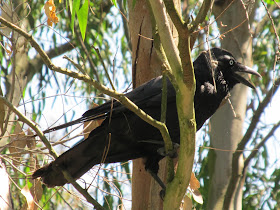In a - currently futile - attempt to add some photos to my newly created bird nests page, I was riding relatively slowly and scanning the overhead branches. I was also trying to ride in a relatively straight line, not collide with other cyclists or pedestrians and - oh yes - keep an eye out for snakes at the same time.
Well, I didn't run anyone down and I suspect it was too hot even for the snakes. I was making frequent stops and did discover several nests, but with no-one appearing to be home I couldn't tell who they belonged to.
I also spent quite some time chasing the perfect bird shot for this year's Barwon calendar. As I lurked amongst the tangled lignum a raven appeared and perched in a nearby eucalypt. (Don't ask me what sort, it's just too darn hard to tell them apart!) It perched for a while, beak open and then left me to continue my sneaking around in the undergrowth.
 |
| Raven aka Crow |
Just before the boat ramp I spotted a Grey Butcherbird - also with its beak gaping. It struck me as odd that I hadn't ever noticed birds doing this before. A little further down the track and I saw a Starling. The same again, and then I came across a small group of Mudlarks. Their beaks were also open, however as they didn't stop shouting the whole time I was nearby so it was a little hard to tell what they were up to.
 |
| Grey Butcherbird |
 |
| Silver Gull aka Seagull |
By now I was fairly sure I was onto something and a quick Google search when I got home proved what I had suspected (and plenty of people probably know already): birds pant or gape when they are hot!
I soon discovered that birds - like dogs - do not have sweat glands, so they rely on other means to dissipate heat. The basic mechanism is still evaporative cooling and in birds this occurs through the mouth by panting - although heat exchange through unfeathered skin (such as legs) also occurs. Some (but perhaps not all?) non-passerine birds (ie those which do not belong to the order Passeriformes) also use a technique called "gular flutter" which involves vibrating the floor of the mouth and the upper parts of the throat.
Another quick Google search told me that ravens, butcherbirds, starlings and mudlarks were all passerines. Great, but what about the seagulls? Well Google didn't want to tell me about the specifics of Australian seagulls and the seagulls didn't mention it either. They just stood in the shade with their beaks hanging open.
From what I did find, gular flutter varies depending on the mechanics of each species' throat but in all cases it is more energy efficient than panting alone. Pelicans can do it, herons can do it too and so do cormorants, ducks, pigeons and a variety of other types of gull, so I guess the seagulls can also.
 |
| White-faced Heron chick |
Of course, the other side of the thermoregulatory coin is keeping warm when the weather is cold. Feathers provide obvious protection, but legs are also very important. In some species, leg veins and arteries are located closely side-by-side so that cool venous blood returning to the body is warmed via heat exchange as it passes arterial blood leaving the core.
Another obvious means of heat retention is of course, covering the bare skin. So, when you see a seagull or a duck standing on one leg, it is most probably not a poor little cripple, it is just a bit cool. Additionally, sitting down to cover both legs, tucking your beak into your side, fluffing up your feathers and facing downwind to minimise the surface area exposed to a cold breeze are also good ways to reduce heat loss if you are a bird.
 |
| Pacific Black Duck |
Interesting. I spotted gulls doing the same thing in Torquay that hot day - first time I've seen it!
ReplyDelete